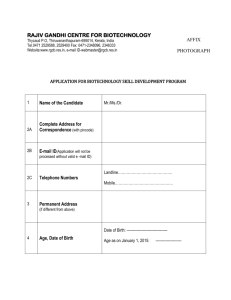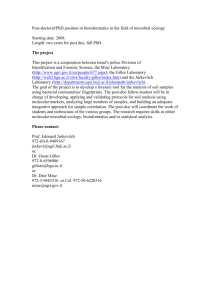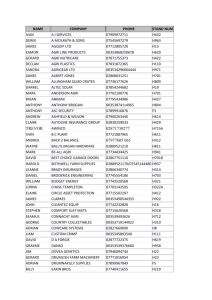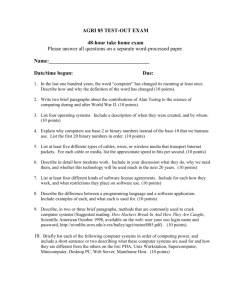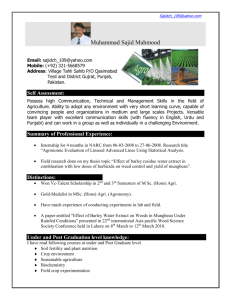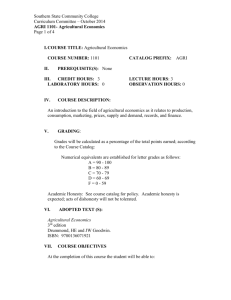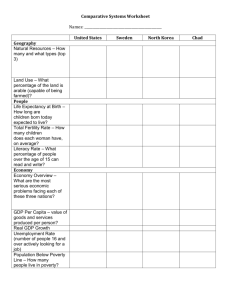agri 1022y(1) - animal science
advertisement
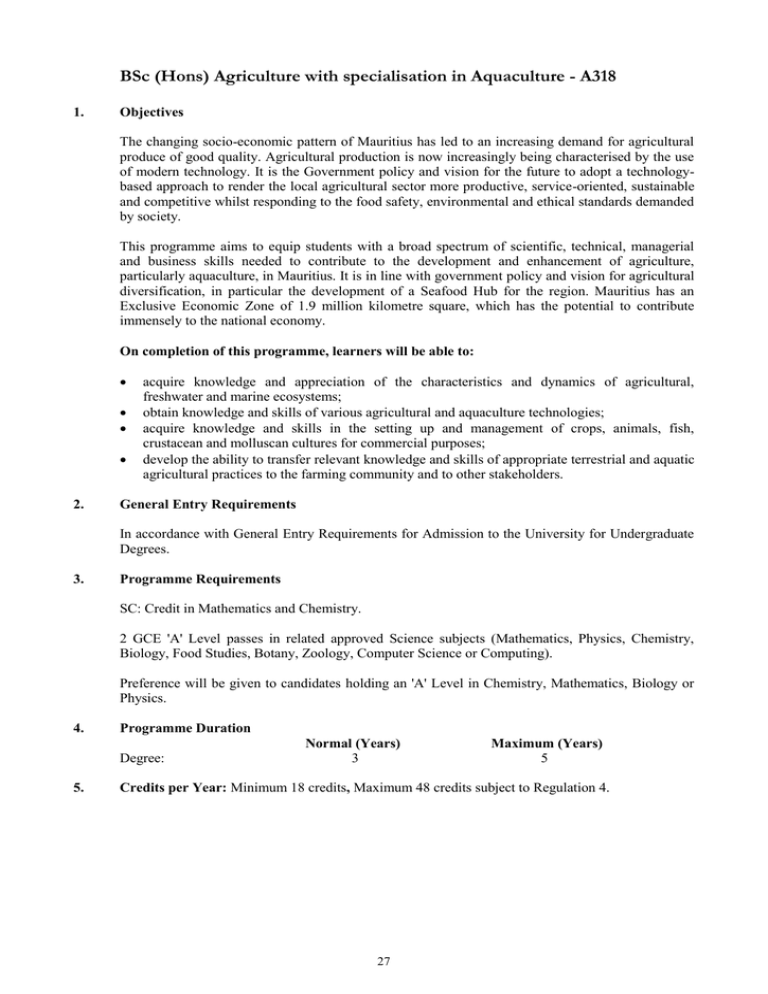
BSc (Hons) Agriculture with specialisation in Aquaculture - A318 1. Objectives The changing socio-economic pattern of Mauritius has led to an increasing demand for agricultural produce of good quality. Agricultural production is now increasingly being characterised by the use of modern technology. It is the Government policy and vision for the future to adopt a technologybased approach to render the local agricultural sector more productive, service-oriented, sustainable and competitive whilst responding to the food safety, environmental and ethical standards demanded by society. This programme aims to equip students with a broad spectrum of scientific, technical, managerial and business skills needed to contribute to the development and enhancement of agriculture, particularly aquaculture, in Mauritius. It is in line with government policy and vision for agricultural diversification, in particular the development of a Seafood Hub for the region. Mauritius has an Exclusive Economic Zone of 1.9 million kilometre square, which has the potential to contribute immensely to the national economy. On completion of this programme, learners will be able to: 2. acquire knowledge and appreciation of the characteristics and dynamics of agricultural, freshwater and marine ecosystems; obtain knowledge and skills of various agricultural and aquaculture technologies; acquire knowledge and skills in the setting up and management of crops, animals, fish, crustacean and molluscan cultures for commercial purposes; develop the ability to transfer relevant knowledge and skills of appropriate terrestrial and aquatic agricultural practices to the farming community and to other stakeholders. General Entry Requirements In accordance with General Entry Requirements for Admission to the University for Undergraduate Degrees. 3. Programme Requirements SC: Credit in Mathematics and Chemistry. 2 GCE 'A' Level passes in related approved Science subjects (Mathematics, Physics, Chemistry, Biology, Food Studies, Botany, Zoology, Computer Science or Computing). Preference will be given to candidates holding an 'A' Level in Chemistry, Mathematics, Biology or Physics. 4. Programme Duration Degree: 5. Normal (Years) 3 Maximum (Years) 5 Credits per Year: Minimum 18 credits, Maximum 48 credits subject to Regulation 4. 27 6. Minimum Credits Required for the Award of Undergraduate Degree: 108 Breakdown as follows: Degree Credits from Core Taught Modules Project 96 9 Elective 3 Students must complete at least one Practical Training satisfactorily for the award of the degree. Students may exit with (a) (b) 7. a Certificate after having earned 30 credits in core modules. a Diploma after having earned 60 credits in core modules. Assessment Each module will be assessed over 100 marks (i.e. expressed as %) with details as follows (unless otherwise specified): Assessment will be based on a Written Examination of 2-3 hour duration, carrying a weighting of 70%, and Continuous Assessment carrying 30% of total marks for AGRI modules. Modules from other Faculties/Departments/Centres will carry weighting in the Written Examination and the Continuous Assessment as specified by the concerned Faculties/Departments/Centres. Continuous Assessment will be based on laboratory/field works, and/or assignments, and should include at least 1 class test. A minimum of at least 30% should be attained in each of Continuous Assessment and Written Examination, with an overall total of 40% for a candidate to pass a module. Modules will carry the weightings of 1, 3 or 5 depending on their status (Introductory, Intermediate or Advanced). Weighting for a particular module is indicated within parentheses in the module code. Modules will carry credits in the range of 3 to 6. Project will carry 9 credits. Assessment of practical training will be based on supervisor’s report and student’s report. For satisfactory completion of the practical training, a minimum of 40% should be attained. Written examinations for all the modules will be carried out at the end of the year. 8. Important Note The rules as stipulated in this Programme Structure and Outline Syllabus will replace all other rules and regulations. 28 9. List of Modules CORE MODULES Code Module Name COMS 1010(1) CSE 1010e(1) AGRI 1018Y(1) AGRI 1019Y(1) AGRI 1020Y(1) Communication Skills Introduction to Information Technology Agricultural Chemistry and Soil Science Crop Science Biology and Control of Plant Pests, Diseases, and Weeds Introductory Crop Production Animal Science Animal Production Food Science and Technology Statistics and Agricultural Experimentation Agricultural Engineering and Applications Introductory Applied Systems, Economics, Management and Extension Biotechnology Freshwater and Coastal Ecology Freshwater Aquaculture and Technology Crop Production Technologies Animal Production and Health Marine Aquaculture and Technology Aquaculture Products, Entrepreneurship and AGRI 1021Y(1) AGRI 1022Y(1) AGRI 1023Y(1) AGRI 2001Y(3) AGRI 2006Y(3) AGRI 2024Y(3) AGRI 2025Y(3) AGRI 2026Y(3) AGRI 2033Y(5) AGRI 2034Y(5) AGRI 3026Y(5) AGRI 3027Y(5) AGRI 3042Y(5) AGRI 3043Y(5) Hrs/Yr L+P Credits D.E. O.E. 45+60 45+60 45+60 3 3 5 5 5 45+60 45+60 45+60 60+60 45+45 45+45 60+60 5 5 5 6 4 4 6 60+60 60+60 60+60 60+45 60+45 60+60 60+60 6 6 6 5 5 6 6 Small Business Management AGRI 1000Y AGRI 2000Y AGRI 3000Y(5) Practical Training* (Year 1) Practical Training*(Year 2) Project ELECTIVES CHOOSE ONE FROM AGRI 3044Y(5) AGRI 3045Y(5) Water Pollution and Control Sustainable Fisheries Management - 9 45+0 45+0 3 3 Total no. of credits: 108 * Students must complete at least one Practical Training satisfactorily for the award of the degree. 29 10. Programme Plan - BSc (Hons) Agriculture with specialisation in Aquaculture YEAR 1 Code Module Name Hrs/Yr L+P Credits Communication Skills Introduction to Information Technology Agricultural Chemistry and Soil Science Crop Science Biology and Control of Plant Pests, Diseases, and Weeds Introductory Crop Production Animal Science Animal Production Practical Training* (6-8 wks to be carried out after Year 1 exams) D.E. O.E. 45+60 45+60 45+60 3 3 5 5 5 45+60 45+60 45+60 5 5 5 - - Module Name Hrs/Yr L+P Credits Food Science and Technology Statistics and Agricultural Experimentation Agricultural Engineering and Applications Introductory Applied Systems, Economics, Management and Extension Biotechnology Freshwater and Coastal Ecology Freshwater Aquaculture and Technology Practical Training* (6-8 wks to be carried out after Year 2 exams) 60+60 45+45 45+45 60+60 6 4 4 6 60+60 60+60 60+60 6 6 6 - - Hrs/Yr Credits CORE COMS 1010(1) CSE 1010e(1) AGRI 1018Y(1) AGRI 1019Y(1) AGRI 1020Y(1) AGRI 1021Y(1) AGRI 1022Y(1) AGRI 1023Y(1) AGRI 1000Y YEAR 2 Code CORE AGRI 2001Y(3) AGRI 2006Y(3) AGRI 2024Y(3) AGRI 2025Y(3) AGRI 2026Y(3) AGRI 2033Y(5) AGRI 2034Y(5) AGRI 2000Y YEAR 3 Code Module Name L+P CORE AGRI 3026Y(5) AGRI 3027Y(5) AGRI 3042Y(5) AGRI 3043Y(5) AGRI 3000Y(5) Crop Production Technologies Animal Production and Health Marine Aquaculture and Technology Aquaculture Products, Entrepreneurship and Small Business Management Project ELECTIVES CHOOSE ONE FROM AGRI 3044Y(5) AGRI 3045Y(5) Water Pollution and Control Sustainable Fisheries Management 60+45 60+45 60+60 60+60 5 5 6 6 - 9 45+0 45+0 3 3 Total no. of credits: 108 * Students must complete at least one Practical Training satisfactorily for the award of the degree. 30 11. Outline Syllabus COMS 1010(1) - COMMUNICATION SKILLS Writing skills, non-verbal communication, modes of speech delivery and presentation aids, speeches, perception and listening skills, business and technical writing. CSE 1010e(1) - INTRODUCTION TO INFORMATION TECHNOLOGY IT and Computers; Stepping in the Computer; Input and Output Devices; Secondary Storage; Programming; Systems Software; Applications Software; Systems Development; Computer Networks; The internet; Computer Security; Software Utilities; Issues and Trends in IT. AGRI 1018(1) - AGRICULTURAL CHEMISTRY AND SOIL SCIENCE Agrochemicals, their properties, metabolism, and mode of action. Chemistry of fertilisers: straight, complex, compound mixed, blended fertilisers. Fertiliser solutions. Foliar fertilisers. Manures, municipal sewage, compost. Chemistry of pesticides: Organochlorines, organophosphates, carbamates, pyrethroids, dinitrophenols, phthalimides, substituted ureas, triazines, inorganics, botanical pesticides, bio-pesticides. Analysis of pesticides and fertilisers. Soil as a natural body. Weathering. Factors and processes in soil formation. Physical, physio-chemical, biological and mineralogical properties of soil. Soil profile. Soil air, water, temperature, soil organic matter and soil organisms. Concepts of soil fertility and land suitability. Soil taxonomy. Soil biology. Soil amendments. Soil pollution. Heavy metals. Polyaromatic hydrocarbons (PAH), persistent organic pollutants (POP) in soils. Soil bioremediation. AGRI 1019Y(1) - CROP SCIENCE Classification, identification, morphology, ecology and uses of economically important crops. Mendelian Inheritance. Linkage and chromosome mapping. Sex linked and extra-nuclear inheritance. Quantitative and population genetics. Objectives of plant breeding. Selection techniques. Methods of crop improvement. Genetic variation and manipulation of variability. Breeding of selected crops. Legislative framework. Environmental influences on crop growth and development. Vegetative and reproductive plant physiology. Plant water relations. Plant growth substances. Plant growth analysis. Yield determination and crop productivity. AGRI 1020Y(1) - BIOLOGY AND CONTROL OF PLANT PESTS, DISEASES AND WEEDS Taxonomy, systematics, biology, ecology and economic importance of pests, plant pathogens and weeds affecting crops. Control and management of pests, diseases and weeds of crop plants. Concept and principles of IPM. Biological, physical, chemical, cultural and biology-based methods of pest control. Economics of crop protection. AGRI 1021Y(1) - INTRODUCTORY CROP PRODUCTION Principles of agronomy. Crop-environment interactions. Cropping systems. Introduction to crop propagation. Plant nutrition. Nutrient deficiency symptoms and their correction. Nutrient requirements and fertiliser recommendations for specific crops/cropping systems. Commercial fertilisers. Green manuring. Organic manures. Field crop agronomy. Husbandry and production of economically important crops. Field operations and techniques in crop production. AGRI 1022Y(1) - ANIMAL SCIENCE Anatomy of non ruminant and ruminant animals digestive systems. Principles of nutritional physiology and biochemistry. Meeting nutritional objectives of farm animals. Feeds and feed evaluation. Production of compound feeds: quality assurance framework. Avian Reproductive Systems and The mammary gland structure. Endocrine effects on animal products: Milk production, egg production. Muscle structure and biology. Growth and body composition. Farm Animal Reproductive systems (Male and female). Reproductive physiology (Oestrous cycles, puberty, pregnancy and parturition. Genetic and physiological adaptation to the environment, especially in hot climate. 31 Principles of Meat science: chemical composition. Post Mortem Muscle Chemistry. Effects of pre and post slaughter treatments on carcass/ meat quality and hygiene. Carcass appraisal. An introduction to the basic principles of quantitative and qualitative genetics. Breeding systems of various farm animals. Disease causing agents. Major Pests and diseases of farm animals. The impact of diseases at the animal, enterprises and national and global levels. Spread and transmission of diseases. The immune system: structure and function. Natural and acquired immunity. Food Borne Diseases. Zoonotic diseases. AGRI 1023Y(1) - ANIMAL PRODUCTION Role and importance of animal production systems in agricultural enterprises: poultry, pigs, beef and dairy cattle, deer, sheep, goats rabbits, production potential of novel species. Constraints to animal productivity and production. Public concerns over animal production practices. Fundamental stockmanship for managing farm animals: rationing; weighing and tagging; usage of preventive and diagnostic equipment; handling and restraining animals, animal’s environment; evaluation of body condition score; performance records. Diagnosing farm animal abnormal behaviour. Animal housing evaluation. AGRI 2001Y(3) - FOOD SCIENCE AND TECHNOLOGY Classification, chemical structure and properties of food constituents and food additives. Chemical composition, properties and nutritional value of food commodities. Primary sensory attributes of foods and perception of food quality. Microbial food spoilage. Useful micro-organisms. Incidence and causes of food borne disease. Characteristics of major food-borne disease micro-organisms. Physical, chemical, sensory and microbiological analysis of foods. Types of nutrients and their role in the human body. Planning a balanced diet. Food laws and standards. Concepts of food quality and safety. Factors which affect quality and safety. Food hazards. Food preservation by heating, chilling, freezing, dehydration, chemicals and ionising radiation. Packaging materials. Processing of selected food products. Process control, application of principles of food hygiene and relevant codes of practice/guidelines to ensure quality and safety. Traceability. Importance of food safety management throughout the food chain. Comprehensive food safety management systems. AGRI 2006Y(3) - STATISTICS AND AGRICULTURAL EXPERIMENTATION Introducing statistics in agriculture. Descriptive statistics – displaying and summarising data. Probability distributions. Point and interval estimation. Hypothesis testing. Analysis of categorical data. Correlation and regression analysis. Design and analysis of experiments: Principles of agricultural experimentation. Analysis of variance. Completely randomised design, Randomised block design, Latin square design. Factorial treatment structure. Non-parametric methods. Data entry and analysis using EXCEL and MINITAB. Introduction to research methodology. Qualitative and quantitative research. Sampling methods. Questionnaire development, design and administration. Data coding and processing using SPSS. Elements of scientific and technical writing. AGRI 2024Y(3) - AGRICULTURAL ENGINEERING AND APPLICATIONS Basic engineering science relevant to agriculture, soil systems and water. Soil tillage. Agricultural machinery: tractors, rotovators, mechanical planters and harvesters, and fertigators. Tractor Technology. Field mechanisation. Pesticide sprayers and fertiliser applicators. Farm roads. Water logging and drainage. Precision agriculture, remote sensing, and GIS. Irrigation systems: Equipment and operation. Soil moisture and soil moisture characteristic curves. Soil water movement. Infiltration rate. Hydraulic conductivity of soil. Nuclear methods of soil moisture determination. Irrigation systems: surface, overhead irrigation and drip Irrigation. Planning and design of various irrigation systems based on soil-water plant climate relationships. Use and maintenance of irrigation systems. Farm structures and farm buildings. Waste management technology. Agro-meteorology. Introduction to controlled environment technology. 32 AGRI 2025Y(3) - INTRODUCTORY APPLIED SYSTEMS, ECONOMICS, MANAGEMENT AND EXTENSION Introduction to agricultural systems concepts: holistic approach to agriculture; an overview of farming systems in the World with particular reference to the SADC region. Applied Economics in Agriculture: Introducing microeconomics and macroeconomics theories. Agriculture and Economic Development: Evolution of the Mauritian agricultural sector from beginnings to present days; challenges facing the Mauritian agricultural sector. Agricultural management: The framework of farm management; introductory farm budgeting. Agricultural Marketing: from commodity marketing to value-addition in agricultural products; marketing functions; marketing channels and costs. Agricultural Extension: introductory concepts and principles; Participatory approach in agricultural research, production & extension. AGRI 2026Y(3) - BIOTECHNOLOGY Structure and functions of cells and organelles; Biomolecules: Polysaccharides, sugars; storage polysaccharides; Lipids, classification and properties, biological membranes; Proteins, amino acids, covalent and three-D structure of proteins; Enzymes, properties and mechanism of actions, enzyme kinetics. Glycolysis. Organisation of genetic material, gene structure, expression and transmission. Control of gene expression. Structure and properties of DNA. DNA replication. Protein synthesis. Principles of gene cloning. Recombinant DNA technology. Concept and basis of biotechnology. Tissue culture techniques and applications. Application of biotechnology in agriculture and crop improvement. AGRI 2033Y(5) - FRESHWATER AND COASTAL ECOLOGY Characteristics and dynamics of freshwater and marine ecosystems and wetlands. Physical, chemical and biological factors affecting productivity. Impacts of natural and anthropogenic activities. Ecotoxicology. Aquatic ecosystem remediation techniques. AGRI 2034Y(5) - FRESHWATER AQUACULTURE AND TECHNOLOGY Introduction to freshwater aquaculture species. Culture technologies. Invasive alien species. Broodstock management and quarantine. Larviculture and nursery rearing. Nutrition, feed formulation and feeding practices. Monitoring of freshwater physico-chemical parameters. Biodata of cultured species. Freshwater fish diseases and control. New methodologies and technologies in freshwater aquaculture. Integrated fish farming. Biotechnological applications. AGRI 3000Y(5) - PROJECT Every student will be allocated a research topic related to aquaculture. The research work will be carried out under academic supervision. Students should demonstrate good practice in using skills and knowledge acquired during the programme and follow dissertation guidelines as laid down by the Faculty of Agriculture. AGRI 3026Y(5) - CROP PRODUCTION TECHNOLOGIES Mechanised vegetable crop production. Plant characteristics for mechanised crop production. Soil conditioning for vegetable production. Seed priming and enhancement. Fluid drilling. Direct sowing for crop establishment. Plug production. Mechanical transplanting. Plastic mulching in horticulture. New trends in vegetable crop production. Good agricultural practices in crop production. Tissue Culture technologies for crop improvement. Cropping and production of high value horticultural crops in plastic tunnels, shade houses and greenhouses. Types of structures for protected cultivation and their characteristics. Greenhouse design and site considerations. Greenhouses and their operation. Plant culture in hydroponics. Plant Nutrition in Soilless Culture. Hydroponics media. Hydroponics systems. Cropping and production of selected vegetables, fruits and ornamentals in soilless culture systems: water culture systems and substrate culture systems. Aeroponics. 33 AGRI 3027Y(5) - ANIMAL PRODUCTION AND HEALTH Principles of managing animals in typical production systems for biological and economic sustainability: poultry, pigs; rabbits; deer; goats and sheep; beef and dairy cows and novel species. Best management practices for their efficient and profitable production: nutrition, reproduction and fertility, housing and equipment, waste management technologies. Food chain management from primary production to consumer use. Trends and current issues related to production and consumption of animal products: meeting the needs of a global market and public concerns. Prevention and control of farm animal disease. Management of disease risks Principles of vaccination. Classification and mode of action of the major classes of drugs. Use and control of drugs. Disease control using non chemical methods. Animal health management schemes for various farm animals. Animal welfare concepts and definition (e.g. the five freedom). Specific requirements for the welfare of named ruminants and non-ruminants. Methods for assessing animal welfare status. AGRI 3042Y(5) - MARINE AQUACULTURE AND TECHNOLOGY Introduction to marine aquaculture. General aspects of aquaculture. Hatchery operations and management. Nutrition, feeding practices and feed formulation. Resource propagation and enhancement. Culture practices and systems. Integrated development projects. Impacts of mariculture on genetic diversity. Impact of escapees on biodiversity. Fish diseases and control. New mariculture methodologies and technologies. AGRI 3043Y(5) - AQUACULTURE PRODUCTS, ENTREPRENEURSHIP AND SMALL BUSINESS MANAGEMENT Quality control and fish handling techniques. Processing of aquatic animal and plant products. Comprehensive food safety. Technologies for harvesting (post-harvest handling & processing techniques of aquaculture products). Preservation of product value and quality. Types of business organisations. Management of agri- and aqua-businesses: Agri- and aqua-business finance. Characteristics of small and medium agri- and aqua-businesses. Public and private organisations facilitating the setting up of an agri- and aqua- business in Mauritius. Setting up of an agri- and aqua-business and development of a business plan. Marketing strategies for an agri- and aqua-business. Case studies. Entrepreneurship: generation of business ideas and innovation. Clustering. International trade and marketing. WTO. Business incubators. Regional opportunities for agri– and aqua- business. Project management and analysis procedures. Origins of EIA. EIA process. Screening and scooping criteria. Environmental issues. Project write-up, project appraisal, feasibility study, viability, IRR, socio-economics and ICZM. AGRI 3044Y(5) - WATER POLLUTION AND CONTROL Main types, sources and fates of aquatic pollutants, ecotoxicological effects on living resources and humans, economic losses due to pollution, monitoring strategy for water quality assessment, technologies to prevent pollution of the water environment including the minimization of wastewaters, treatment and removal of contaminants, oil pollution and its treatment, the causes, consequences and remedies for eutrophication and Harmful Algal Blooms (HABs), and Environmental Impact Assessment (EIA). AGRI 3045Y(5) - SUSTAINABLE FISHERIES MANAGEMENT Characteristics, dynamics, interrelationships and productivity of benthic, demersal and pelagic fish species. Stock assessment and recruitment. Population and community dynamics. Fisheries habitat. Contaminants in fishes. Toxic species. International, regional and national laws and legislations governing fisheries and marine resources. 34
